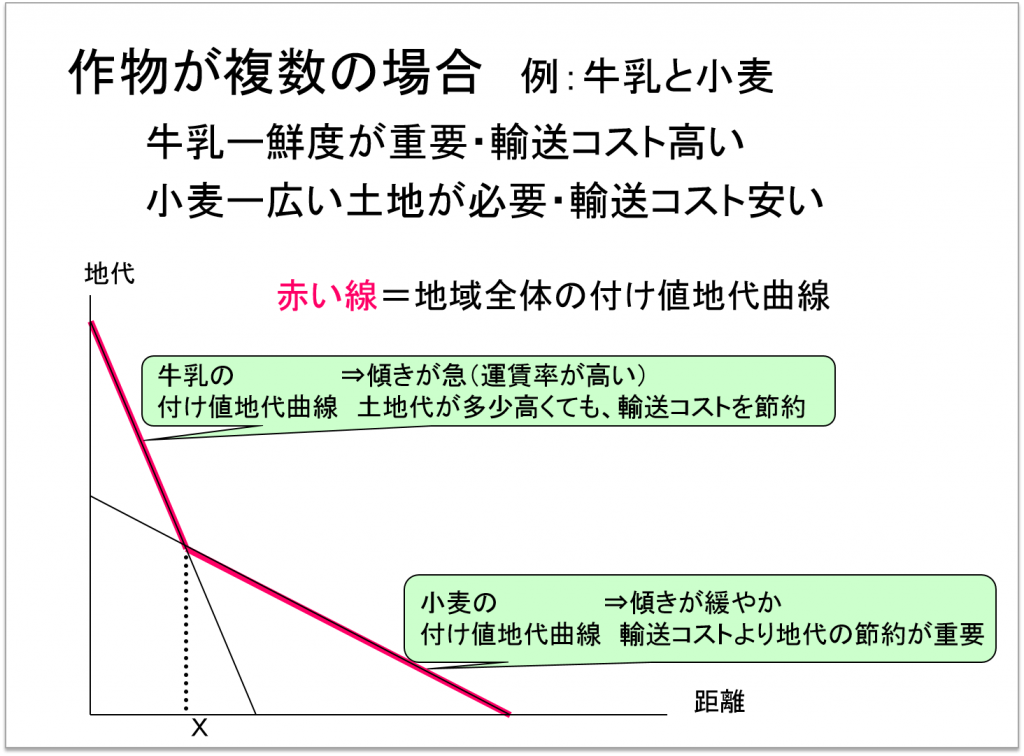私たちが生きている世界には、
身近なことから人類全体に関わることまで、
さまざまな問題が溢れています。
意外に知られていない現状や真相を、
本学が誇る教員たちが興味深い視点から
解き明かします。
経済学は、複雑多岐に渡るわれわれの経済という営みを、可能な限り単純な仮定のもとで説明しようとします。しばしば批判される「経済人」(自己の経済的利益の最大化のみを考慮して行動する人間)という仮定もそうですし、売り手と買い手が「市場(しじょう)」で取引をして、そこで生産量や価格が決まるというのも、同様の仮定に過ぎません。これらの仮定が非現実的であることは、他ならぬ経済学者が一番よく知っています。その上でその仮定を用いることでどこまで現実の経済を説明できるのかが問われます。そしてそれでは説明しきれない問題が出てきたときには、仮定をどのように変更すればよいかを柔軟に考えるのも経済学の特色です。私の専門である「地域経済学」という分野は、経済学の理論に「空間」という要素を導入する、言い換えれば経済を「空間的に」考えることで、現実の経済で生じている様々な問題を説明し、その対策を検討するものです。では、経済を空間的に考えるとはどういうことなのか、少し検討してみましょう。
経済学の初級のテキストでは、例えば「りんごを買いたい消費者(買い手)」と、「りんごを売りたいという農家(売り手)」が、いつも隣にいるかのように仮定した説明が往々にしてなされます。ですが、現実には買い手は東京に、売り手は青森にいるというように、両者は「空間」によって隔てられています。売買をするためには、消費者が青森に買いに行くか、もしくはりんごを東京に出荷する必要があります。そのため実際に取引する際には、りんごもしくは人間の「輸送コスト」を考慮する必要があります。青森で大量にりんごが生産されていても、輸送コストがあまりに高ければ(あるいは、鉄道も高速道路もない状態を想像してください)東京ではりんごは買えないのです。
別の面から考えると、りんごの産地は青森だけでなく、長野や山形や福島もそうですね。みなさんは社会科の授業で、「りんごは涼しい気候を好む作物なので、青森などでもっぱら生産される」と習ったことと思います。でもそれは事実を半分しか説明していません。りんごの需要が大きい(買い手が多い)のは東京なのですから、もしかしたら東京でりんごを作った方が、輸送費が節約できるので好都合かもしれません。ではなぜ「東京産のりんご」はほとんど見当たらないのでしょうか?それは東京で「無理をして」りんごを作ることで余計にかかる生産コスト(出来上がるりんごがおいしくない、ということもコストの一種です)と、青森からりんごを運んでくる輸送コストを比べたとき、後者の方が安いという現実があるからです。この大小関係は決して不変のものではありません。輸送コストの水準や、りんごの品種改良などの結果によっては、大小関係が逆転することもあり得るのです。また、青森に比べれば長野ははるかに東京に近い(=輸送コストが低い)のですが、それでも青森のりんごが東京にたくさん出回っているのは、輸送コストの増加を打ち消すだけのメリット(品質や安い生産コストなど)があるからでしょう。ここまで考えて初めて、さまざまな産物がなぜ特定の場所で生産されるのかが見えてくるのです。
これはりんごなどの農産物に限ったことではありません。工業でも、はたまたサービス業でも、なぜその産業がそこに立地するのかを説明する論理はほぼ共通です。むしろこれらの産業の方が、生産コストと輸送コストの大小関係の逆転がおこりやすいので、かつての産地が没落して別の場所が産地として有名になる、といった変化がみやすいという特徴があります。
「地域経済学」という分野では、このような問題を扱います。「地域経済学を専門としている」と話すと「どこの地域が専門ですか」と聞かれることが多いのですが、特定の地域のことだけを具体的に考える学問ではなく、東京の話であれ、ニューヨークの話であれ、上海の話であれ、それをどこの地域にもあてはまる理論として構築して実証するのが地域経済学の特徴です。あるいは、地域という言葉はしばしば「田舎」という意味で用いられるきらいがありますが、地域経済学が扱う地域とはそのような特定の性質を持つ場所のことではなく、あくまでも普遍的な「空間」を意味しています。空間という要素を考慮することによって生じるさまざまな課題、経済活動の立地や地域間の交易、あるいは集積などについて、経済理論を応用して考える、というのが地域経済学の基本となります。
いろいろな経済活動が、どこで行われているのか、行われるべきなのかという疑問を持った瞬間から、それは地域経済学の領域となります。以下ではもう少し具体的な例を挙げて考えてみましょう。
みなさんは、牛乳の産地と言えば、北海道を真っ先に連想するかもしれません。確かに牛乳の生産量を統計でみると、北海道は全国1位で牛乳の産地として他県を大きく引き離しています(2位の約10倍)。他方、2位以下に目を移してみると栃木・群馬・千葉などがランキングの上位に入ってきます。これは東京という大消費地のそばで生産するメリットがあるからです。土地代だけを考えると北海道の方が安そうですが、北海道から東京まで牛乳を運ぶと輸送コストが多くかかってしまいます。しかし栃木、群馬、千葉は、東京に近い分、輸送コストは北海道ほどかかりません。土地代と輸送コストのこのような関係を「トレードオフ」と呼びます。この関係を示したのが付け値地代曲線(図版1)です。輸送コストは市場(ここでは東京)からの距離によって決まる一方、牛乳を生産する酪農家の収入は変わりません(と仮定します)。収入から輸送コストを引いた分が土地代となる(だから、北海道の方が土地代は安いのです)ので、図版1のような関係が得られるのです。この付け値地代曲線の傾きは、運ぶ時の運賃率の違いなどもあって、作物によっても異なります(図版1では牛乳と小麦を例にとってあります)。農家が土地を地主から借りている(これもそう仮定します)とすると、貸す地主の側は自分により多くの土地代を払ってくれる側に土地を貸すはずで、その結果、運賃率が高い牛乳は東京の近く(図版1ではX点より左側)で生産されることになるのです。
(図版1)

とは言うものの、スーパーなどではパッケージに「北海道産」と書かれた牛乳を見かけることも多いかもしれません。実際には北海道の方が牛乳の生産コストが安いかもしれませんし、輸送技術の発達により輸送コストの差が小さくなったかもしれません。あるいは「北海道=牛乳の本場」という意識から、少々高くても北海道産の牛乳を選ぶ、という消費者もいるかもしれません。それらの要因を考慮してやると、北海道でも牛乳の生産が行われることを説明することはできます(説明は省略しますがみなさんで考えてみてください)。ただ北海道の牛乳を使用する際にも、パック詰めは東京の近郊でする場合が多いはずです。個々のパック牛乳を北海道から運ぶよりも、タンクか何かで大量に牛乳を運んでからパック詰めした方が、近郊にパック工場を造る費用を考慮しても、はるかに輸送に手間がかからず費用も安く抑えられるからです。
ところで、なぜ北海道は他県よりも牛乳の生産量が多いのでしょうか。それは北海道では、飲料用の牛乳だけでなくチーズやバターの原料となる牛乳も生産しているためです。ちなみにチーズやバターなどの乳製品の生産場所は北海道の場合が多いですね。これは牛乳1トンから生産されるバターやチーズは1トンよりはるかに軽い=輸送コストが安いためです。同じ乳製品でも、飲用乳のパック詰めは東京近郊で、バターやチーズの生産は北海道で行われているという現実は、輸送コストの違いによって簡単に説明できるのです。
もうひとつ別の例として、今度は「コールセンターの立地」について考えてみましょう。近年、地方にコールセンターを置く企業が増えています。私がある生命保険会社のコールセンターに電話した際、先方から折り返し携帯に電話をかけてくれたのですが、その時の電話の市外局番が「長崎」になっていたので驚いたことがあります。これはコールセンターを東京に置くよりもオペレーターの人件費が安いうえに、オフィス代も東京より長崎の方が格段に安く済むからです。コールセンターの場合ですと、フリーダイヤルを設置して企業が電話代を負担する場合も多いと思います。人口から考えると首都圏の人が電話をかけてくることが多いはずですから、首都圏から東京のコールセンターに電話をかけてもらう方が、首都圏から長崎へかける電話代より安く済むはずですが、近年電話料金(=「情報」の輸送コスト)が安くなったので、このような立地が可能になったのです。
実は英語圏ではもっとグローバルな立地がなされていて、アメリカ合衆国の消費者向けのコールセンターがフィリピンやインドに立地する場合があるのだそうです。それは単に賃金水準が低いからだけではなく、時差の関係でアメリカでは深夜の時間帯がこれらの国々では日中になるので、コールセンターを24時間対応にしても(この場合、何時に電話するかによって世界のどこのコールセンターにつながるかが変わるのが普通です)オペレーターに深夜勤務手当を支払う必要がない、というメリットもあるのです。
最後に、今日の日本で今なお進行している「東京一極集中」について、地域経済学の立場からコメントしたいと思います。東京には行政機能や企業の本社機能、あるいはマスメディアや大学などが集まっているため、東京圏への人口流入が進んでいます。反面、それ以外の地方では人口が流出し、街の中心部にある百貨店が閉店したり、さらに人口の少ない地域では鉄道やバス路線が廃止されたりするケースも目立ちます。これらを捉えて、「東京一極集中は東京のみを繁栄させ、それ以外の地方は損するばかりである」という議論が後を絶ちません。最近では、「このまま東京への人口集中が続くと全国で多数の地方自治体が『消滅』する」という指摘が話題を集めています。
地方の人口流出がもたらす負の影響はもちろんありますし、他方で流入する人口を受け入れる東京の側にも様々な問題(通勤電車の混雑や保育所の不足など)があります。ここでは別の視点から、東京一極集中が日本全体にもたらす「メリット」について考えてみましょう。
東京をはじめ、大都市の魅力はその「多様性」にあります。例えば田舎の「洋品店」では、無難な白いTシャツしか売られていないかもしれませんが、東京・原宿の「ショップ」では様々な色・柄のTシャツが売られています。このとき、洋品店の白いTシャツは1,000円で買えるのに対して、原宿のショップで売られているTシャツは1,500円くらいするかもしれません。それでも、自分の好みにぴったり合うものであれば、500円余計に払ってでも欲しいと思うのが人情です。これをショップの側からみると、東京ではデザインがよければ500円高くTシャツが売れる、ということにつながります。このことは様々なデザインの「ショップ」をさらに東京に集めることになります。ショップが集まることでさらに多様なデザインのTシャツが売られることとなり、これまでのデザインに飽き足らなかった人々をも東京に惹き付けることになるでしょう。
ここで重要なのは、「洋品店」では1,500円の(多様なデザインの)Tシャツを買うことは難しい、ということです。それは田舎の洋品店が直面する需要が小さいため、万人受けするような「無難な」Tシャツを売るよりないからです。言い換えれば、田舎にいる限り自分の好みにぴったり合ったTシャツは手に入らない、ということです。これはもちろんTシャツだけでなく、様々な商品について言えることですし、あるいは働く場所についても同様なことが言えます。例えばアラビア語が堪能な人がいたとして、彼(女)の能力を必要とする職場が日本の田舎にはほとんどありません。でも東京に出てくれば、中東諸国と取引する商社など、その能力を欲する職場を見つけることは比較的容易でしょう。
(図版2)

このような関係を整理したのが図版2です。(東京に)多くの人が集中することは、その人達の需要を満たすための多数の企業が集積することにつながります。そして多数の企業が集積することはそこで供給される商品やサービス、あるいは雇用の多様性を増大させることにほかなりません。それによって人々の満足度が高まり、さらに多くの人が東京に集まることとなるのです。これが東京一極集中です。
こうして東京では、多様な人々の好みを満たす多様な商品やサービスが供給され、多様な人の能力を活かす職場が用意されています。これらは、東京という巨大な集積があって初めて可能になることなのです。今日では「Tシャツならネット通販で買える」と思うかもしれませんが、それは多数の企業が成立した後だから言えることであって、何もないところにインターネットだけがあってもそれを使ってTシャツを売ろうと企業が考えるかどうかは疑問です。むしろ重要なことは、集積の中で多数のショップが生まれてきたからこそ、東京以外の人も多様なデザインのTシャツを(ネット通販を含めて)買うことができる、ということです。気がつけば東京では、日本中さらには世界中の人々を惹き付けるようなものが日々生み出されています。それは東京にこれだけの人口が集積したこと=東京一極集中が始まりなのです。別の面からは、東京で生産される多様なものに必要な「原料」や「部品」が、東京以外の地域から供給されている、という事実を指摘する必要もあります。それはわずかずつでも、その地域に雇用をもたらし、経済を潤わせているはずだからです。
日本に東京という世界有数の大都市圏が存在しているということは、東京に住んでいる人だけではなく、日本全体にとってメリットがあることなのです。東京の一極集中化で地方が損をしているかと言えば、一概にそうとは言えないということです。巨大な集積があるところだから存在し、享受することができるさまざまなサービスが東京において生まれていますし、そのような集積の存在がビジネスでも有利に働く場合が多いのです。また周辺のアジア諸国との競争も視野に入れた時には、日本に東京という一大拠点があることのメリットは決して小さくないですし、世界の中での日本のプレゼンスを高めていると思います。
(2018年掲載)